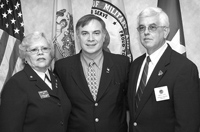Photo and story by Kryn Westhoven, NJDMAVA/PA
The goal for the
various veterans
groups is to be updated
on current DMAVA programs
and discuss
mutual legislative goals
so that information
could be passed along
to the membership at
the upcoming state
conventions.
Brig. Gen. Maria
Falca-Dodson, Deputy
Adjutant General,
briefed the attendees
on the current deployments
of the New Jersey
National Guard and discussed
the still ongoing developments of
the BRAC decisions, to include status
of the VA clinic located on Fort
Monmouth. Dodson stated that VA
health care should remain on the
soon to be closed post and everyone
was working towards that goal.
One idea DMAVA is looking into
is the possibility that the VA clinic
could be relocated to the Patterson
Army Hospital. The idea is to convert
the rest of the hospital into a
Veterans Haven, expanding on the
success of the transitional housing
program in Winslow Township,
while adding up to 200 beds for
homeless veterans who would like
to enter the program according to
Col. (Ret.) Stephen G. Abel, Deputy Commissioner for Veterans Affairs.
The department has visited the
facility and will determine if the
former Army hospital will work for
such a program before formally requesting
that the property be turned
over to the state as part of the
BRAC process. “We are looking
four or five years from now, this is
a long range plan,” noted Abel.
The veterans share a concern
to see the passage of legislation
that would realign state regulations
to mirror federal guidelines on how
to determine eligibility for veteran
benefits. DMAVA Director of Government
Relations, Dr. Wayne
Girardet explained the potential
cost to the state and local governments
should legislation referred to as ‘Vet Is A Vet’ is approved.
There would be a
nearly $24 million dollar
cost to the state to pay
for the $250 property tax
deduction if state eligibility
matched the federal
rules. It is estimated by
Girardet that local governments
could lose
more than $29 million
dollars for property tax
exemptions for 100 percent
disabled veterans.
The Veteran’s Retirement
Allowance and Civil
Service preference
would have a minimum
financial impact especially
the preference provision,
which is where
the department would
like to start the ‘Vet Is A
Vet’ process.
“Take one bite of the
apple at a time,” said Abel, as he
spoke about breaking down the ‘Vet
Is A Vet’ issue into smaller pieces.
At the Veterans Leadership Call
in December, then Governor-elect
Jon Corzine indicated his support
for the ‘Vet Is A Vet’ legislation.
Next up to speak was Brig.
Gen. Frank Carlini, Director of Veterans
Healthcare as he addressed
several issues pertaining to the
three Veterans Memorial Homes.
Currently the homes are all above
a 96 percent occupancy rate with
Menlo Park and Paramus housing
more than 300 veterans each and
with Vineland moving towards that
number as the new wing is populated.
While that is good news for
the homes, the bad news is that no New Jersey projects made the VA
construction list for this year. The
replacement of the heating and air
conditioning system at Paramus is
a department priority, and every
effort will be made to move that
project up the VA’s list for funding
for this year or next.
The public comment period on
changes to New Jersey Administrative
Code 5A-5, that covers
DMAVA facilities, has closed according
to Carlini. One of the major
changes to the code, was to
liberalize the admissions policy.
This makes additional former service
members eligible to apply for
admission to the memorial homes.
The percentage of non-veterans
who can apply to the homes, which
covers spouses and Gold Star parents,
will be increase from five to
twenty percent.
Carlini noted that the current
application is being standardized
and streamlined for all three memorial
homes and will be published
on the DMAVA website.
The department continued to
stress the need for veterans’ organizations to encourage their members
to get their VA disability claims
reevaluated. “A bad knee doesn’t
get better with age,” added Abel.
The $35-million dollar expansion
at the Brig. Gen. Doyle Veterans
Memorial Cemetery continues
to move forward as the new administrative
and maintenance facility
construction is on schedule. The
plans to covert the old maintenance
building near the entrance to the
cemetery into a public information
center will be several years away
as the more pressing issue of providing
additional burial plots or
crypts are a priority for the next four
to five years.
The veteran leaders talked
about the annual Stand Downs for
homeless vets. The Veterans of
Foreign Wars proposed that the
Stand Down be longer than a single
day, more like the three-day Stand
Down event previously held at Fort
Dix.
The department will ask the
groups that coordinate the North
and South Jersey Stand Down’s to consider combining the two into a
single multi-day event to service
the estimated eight thousand homeless
veterans in the state.
One of the key concerns with
the Stand Downs in any format is
how to get the information out to the
veterans you are trying to help.
“These veterans do not have
cable TV or have the newspaper
delivered to their door every day,”
said Gary Englert, Director of Veterans
Services.
When asked about how to track
the wounded or Killed In Action service
members in the ongoing Global
War on Terrorism, Englert
recommend a website, www.thefinalrollcall.us/, as a good source
for the latest information.
By the end of the half day session
the veteran organizations commanders
were better informed on
the current status of programs in
the state and agreed that working
together is the best way to leverage
the power of membership, because
the bottom line is every one
is a veteran first.



| TABLE OF CONTENTS |

Veterans Leaders Get the Word Out


